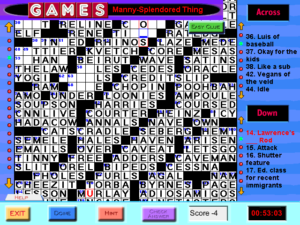Games Interactive: World’s Most Ornery Crossword
 Games Interactive seems to have only one World’s Most Ornery Crossword. I suppose that’s fitting. The magazine only ever carried one per issue, as a sort of capstone to the “Pencilwise” section. If they had published more than one at a time, it would cast doubt on the “World’s Most” claim. Things are no different here.
Games Interactive seems to have only one World’s Most Ornery Crossword. I suppose that’s fitting. The magazine only ever carried one per issue, as a sort of capstone to the “Pencilwise” section. If they had published more than one at a time, it would cast doubt on the “World’s Most” claim. Things are no different here.
There are two distinguishing things about World’s Most Orneries. First, there’s the size. The grid is 25×25, which is larger even than the Sunday puzzle in the New York Times. The makers of Games Interactive decided not to fit this all onto the screen at once, instead making it scroll vertically, even though they really didn’t need to. Even under the constraints of the game — running at 640×480 resolution, with a 43-pixel header and a 50-pixel footer — there’s room enough for 25 rows of 15-pixel squares, which is large enough to hold the font used for the clues, along with a black line separating rows and a two-pixel margin. As it is, we instead have 19-pixel squares. 25 rows of 19 pixels takes 475 pixels. So perhaps 19 pixels was chosen because it’s the largest size that they could use and still fit an entire World’s Most Ornery Crossword on a 640×480 screen. If so, it’s too bad they messed it up by using up vertical space with headers and footers.
Selecting a word, whether with keyboard or mouse, automatically scrolls the grid to make the entirety of that word visible. This is fortunate, because the scrollbar is unreliable. Navigating between words with the arrow keys is also broken: trying to move up or down instead moves the cursor a bunch of spaces left or right. I haven’t probed this deeply, but I’m guessing that the navigation code is assuming a 15×15 grid, the size of all the easy crosswords in the collection.
The other distinguishing feature of the WMOC is that it has two sets of clues: the Hard Clues and the Easy Clues. In the magazine, the Easy clues were printed on half of an adjacent page, with the intent that you’d use the Hard clues by default and could switch to Easy by folding the page over. Resorting to Easy always felt a little like cheating, but it was at least a relatively honorable form of cheating. In Games Interactive, there’s a button for switching to Easy, but, interestingly, it only affects the currently-selected word, minimizing the cheat factor.
There’s another cheat mechanism shared by all the crosswords in the game: the Hint button, one of the few ways that the puzzles in this game benefit from being computerized. Pressing this button deducts a point from your score and reveals a random letter in the current selected word, possibly a letter you’ve already filled in correctly. I’ve resorted to requesting hints on a few occasions when the puzzles expected me to know the names of athletes or musicians, but it’s not clear to me if it hurts your score less than just getting a letter wrong. Anyway, even though Easy is cheaty, and the game treats it as such, it doesn’t consider it to be the same sort of cheaty as Hints. Easy doesn’t affect your score at all. The only motivation you have for not dropping down to Easy is your own sense of honor — which is the case for a lot of computer games, come to think of it.
 Comments(0)
Comments(0)